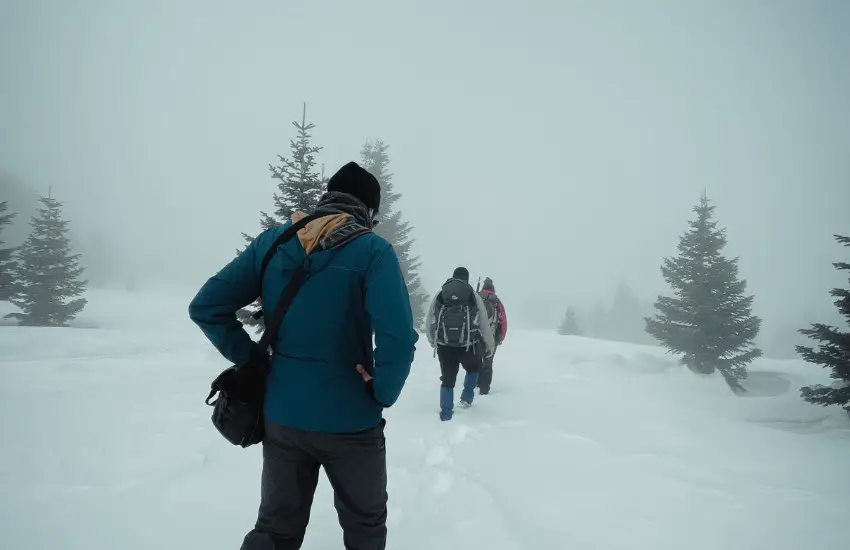What is the Lowest Temperature a Human Can Survive Outside?

Winter is here, and so are the freezing temperatures that come with it. It’s important to know how to protect yourself when the temperature drops to avoid hypothermia and other cold-related illnesses. But have you ever wondered what’s the lowest temperature a human can survive outside? Keep reading to find out.
Knowing the lowest temperature a human can withstand is essential in avoiding the dangers of frostbite, hypothermia, and even organ failure. In this article, we’ll discuss the scientific factors affecting cold tolerance, provide real-life examples of cold survival, and give tips on how to stay safe in freezing temperatures.
So, grab a cup of hot cocoa and settle in as we explore the world of frigid temperatures and the human body’s ability to withstand extreme cold.
Quick Links
Factors Affecting Cold Tolerance
What makes some people more adapted to cold weather than others? Is it because they wear extra layers or because they have a different body composition? Let’s break down some of the scientific factors that affect our cold tolerance.
- Body composition: Did you know that body fat acts as natural insulation for our bodies? It’s true! A person with more body fat can naturally withstand colder temperatures because the fat acts as an insulator. That extra large milkshake didn’t go to waste after all!
- Age and gender: It’s no secret that women and older adults have less cold tolerance than younger men. This difference can be attributed to body composition, as women typically have less muscle mass and more body fat than men, making them more susceptible to the cold.
- Clothing and insulation: What you wear matters! Clothing is the first line of defense against extreme cold temperatures. Layering properly and wearing insulating fabrics like wool or down can make all the difference.
- Activity level and metabolism: Moving around generates body heat and keeps us warm. A person with a higher metabolism can generate body heat faster and withstand colder temperatures for longer periods.
- Wind chill and humidity: Wind chill and humidity can change how cold temperatures actually feel to our bodies. Wind chill makes us feel colder because it blows away the warm air around us. On the other hand, high humidity can make the air feel colder than it actually is.
By taking these factors into account, we can better understand why some people can endure extremely low temperatures, while others struggle to stay warm in mildly cold weather – and a factor that affects all.
What Is the Lowest Temperature a Human Can Survive Outside?
The lowest temperature a human can survive outside largely depends on the factors we discussed in the previous section. While the human body can survive extremely low temperatures, it can only do so for a limited amount of time.
Generally speaking, the lowest temperature at which a human can survive is around -32°C (-26°F). Beyond that temperature, hypothermia can occur, which is a life-threatening condition in which your body loses heat faster than it can produce it.
When the body temperature drops below 35°C (95°F), hypothermia occurs, leading to symptoms such as shivering, confusion, and slowed breathing and heart rate. If left untreated, hypothermia can lead to decreased consciousness and eventually, death.
It’s important to note that certain individuals, such as those with medical conditions or impaired immune systems, may be more susceptible to hypothermia, even in above-freezing temperatures.
In the next section, we’ll get dive a bit more into the hypothermia part.
The Science of Hypothermia: Understanding the Risks and Symptoms
Winter sports, snow-day activities, and cold-weather adventures can be exciting, but they can also pose a danger to your health if you’re not careful. When it comes to spending time outside in cold temperatures, one of the most significant risks is hypothermia. In this section, we’ll explore exactly what hypothermia is and the risks and symptoms associated with it.
A. Definition and Symptoms
Hypothermia is a medical condition that occurs when the body’s core temperature falls below the normal range of 36.5–37.5°C (97.7–99.5°F). And again, according to Mayo Clinic, it’s when your body temp hits 35°C. This can happen when the body loses heat faster than it can produce it. Symptoms of hypothermia can include:
- Shivering
- Confusion
- Slurred speech
- Uncontrolled movements
- Loss of coordination
- Slow breathing and heart rate
- Fatigue and drowsiness
- Impaired judgment and decision-making
- Reduced consciousness or unconsciousness
It’s important to note that in severe cases, hypothermia can lead to heart failure, respiratory failure, and eventually death.
Stages of Hypothermia
Hypothermia is divided into three stages:
- Mild hypothermia: This occurs when the body’s core temperature falls between 32–35°C (89.6–95°F). At this stage, shivering and rapid breathing are common, as the body tries to generate heat and warm itself up.
- Moderate hypothermia: In this stage, the body’s temperature falls between 28–32°C (82.4–89.6°F), and shivering and muscle rigidity intensify. The person may become confused, agitated, and have trouble moving or speaking.
- Severe hypothermia: At this stage, the body’s core temperature drops below 28°C (82.4°F), and shivering stops. The muscles become weak and slack, and the person may experience slurred speech, a slow pulse, and shallow breathing. In the late stages, they may experience decreased consciousness, leading to shock, coma, and eventually death.
Risks and Complications
While hypothermia is commonly associated with cold weather and exposure to extreme outdoor temperatures, other factors can increase the risk of hypothermia. Some of these factors include:
- Age: Infants, older adults, and those with chronic illnesses are more susceptible to hypothermia.
- Alcohol and drug use: Alcohol and drug use can impair judgment, which can lead to poor decision-making and put you at risk for hypothermia.
- Immobility: Being immobilized due to injury or illness can slow down bodily functions like shivering, slowing down heat production, and leading to hypothermia.
- Wetness: Wet clothing will lose heat much more quickly than dry clothing.
Complications from hypothermia can range from mild, like frostbite and trench foot, to severe, like organ failure leading to death. So it is essential to take hypothermia seriously and take immediate action to avoid it.
Now that we understand the risks and symptoms of hypothermia let’s discuss how to prevent it in the following section.
Tips for Cold Weather Survival: How to Stay Safe and Warm
While it’s exciting to spend time outside in the winter, it’s crucial to take the necessary precautions to stay safe and warm. In this section, we’ll explore some practical tips for cold-weather survival.
Dressing Appropriately
One of the most crucial things to consider when spending time outside in the cold is dressing appropriately. Layering is key! Start with a base layer that wicks away moisture and keeps you dry. Next, add an insulating layer for warmth, and top it off with a waterproof and windproof outer layer. Don’t forget to cover your head, neck, and hands to prevent heat loss. It’s also essential to avoid cotton, which retains moisture and will leave you feeling cold and damp.
Staying Dry and Hydrated
Protecting yourself from getting wet is critical when it comes to cold weather survival. Wet clothes can increase heat loss and put you at risk for hypothermia. Consider packing extra layers to change into if needed. Staying hydrated is also critical for cold weather survival. Even though it’s cold outside, you can still become dehydrated (which is not common knowledge), so be sure to drink plenty of water and avoid alcohol and caffeine.
Building a Shelter
A shelter can help protect you from the wind and elements, which can reduce heat loss and keep you warmer. If you find yourself in an emergency situation, constructing a shelter should be a top priority. Utilize natural materials like leaves and branches to create a barrier between yourself and the cold ground.
Starting a Fire
A fire can also be essential for cold weather survival. It can provide warmth and light, help dry out wet clothes, and provide a signal for rescuers. Always bring supplies to start a fire if you’re spending time outside in the cold. Dry wood and kindling are essential, as are waterproof matches or a lighter. But remember, safety first! Be sure to build your fire a safe distance away from any flammable materials.
Keeping Active
Staying active is a great way to stay warm in cold weather. Movement generates heat, so consider doing some light exercises like jumping jacks or jogging in place to get your blood flowing. Take frequent breaks and don’t overexert yourself—too much activity can lead to sweating, which can lead to hypothermia if you become wet.
Conclusion
While winter weather can be beautiful and exciting, it can also be dangerous if you’re not prepared. The good news is that by incorporating a few simple steps into your routine, you can ensure that you and your loved ones stay safe and warm during the colder months.
So, whether you’re hitting the slopes, taking a winter hike, or simply enjoying the beauty of the season, remember to stay safe and stay warm. With a little preparation and a lot of common sense, you can make the most of the winter months and enjoy all that the season has to offer.
FAQs Related to Cold Tolerance: What You Need to Know
If you’re planning on spending time in cold weather, it’s essential to be informed and understand the risks. In this section, we’ll explore some commonly asked questions related to cold tolerance.
What is the Lowest Temperature a Human Can Survive Outside?
The lowest temperature at which a human can survive depends on many factors, including clothing, activity level, and individual factors like age and health. However, the average person can survive temperatures between -22 and -40 degrees Fahrenheit for a short period with the right preparation and protection. Still, it’s essential to note that exposure to these temperatures for prolonged periods can be extremely dangerous.
How Long Can a Person Survive in Freezing Temperatures?
Again, this depends on many factors. However, without adequate protection, a person may only last a few hours or less in freezing temperatures before developing hypothermia or frostbite, both of which can be fatal.
Can You Die from Hypothermia in Your Sleep?
Yes, it’s possible to die from hypothermia in your sleep. Your body temperature drops as you sleep, and if you’re not adequately protected, you can develop hypothermia. In extreme cases, this can result in death.
How Does Alcohol Affect Cold Tolerance?
It’s a common misconception that alcohol can help you stay warm in cold weather. Alcohol actually dilates blood vessels, which can lead to increased heat loss and hypothermia. It can also impair judgment and decision-making, leading to risky behaviors in cold weather.
Can You Get Frostbite Even If It’s Not Below Freezing?
Yes, it’s possible to get frostbite even if it’s not below freezing. Your body loses heat faster in windy and wet conditions, which means you’re at risk for frostbite, even if the temperature is above freezing. Be sure to wear appropriate clothing and stay dry to prevent frostbite.







